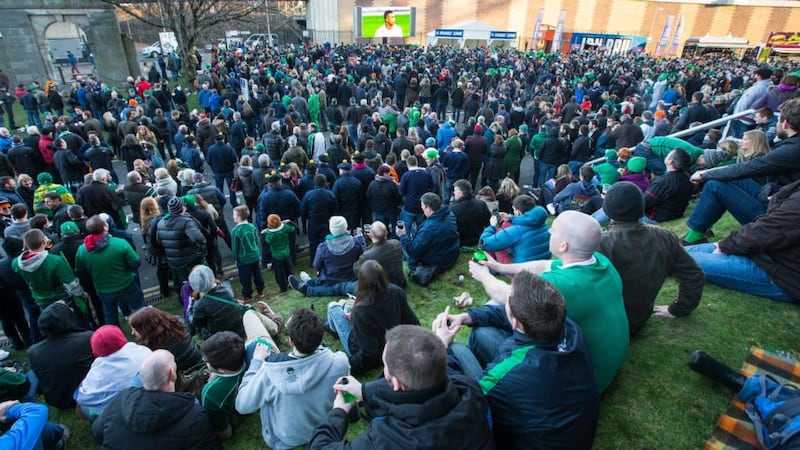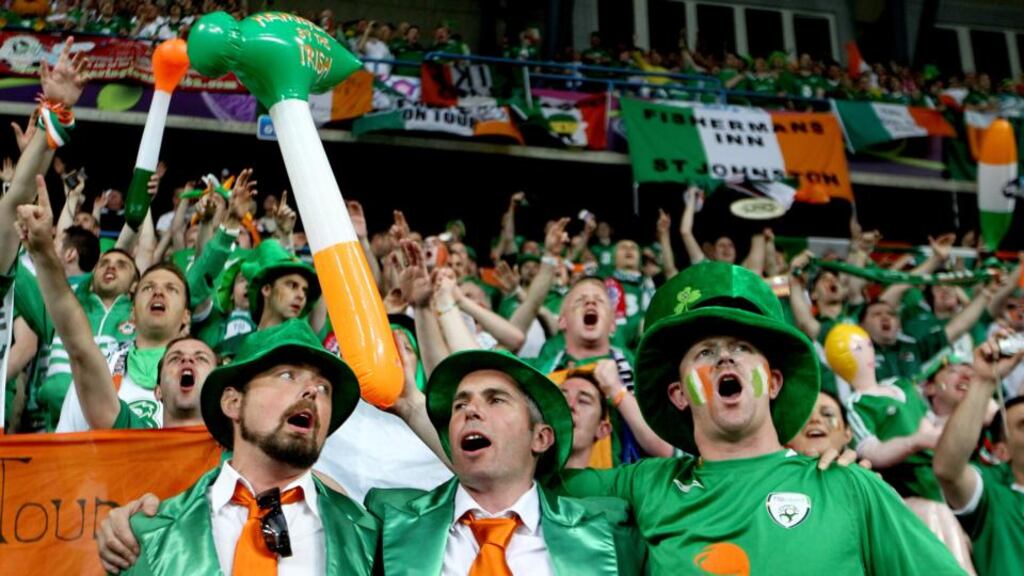I once had a conversation with an Irish soccer international a couple of days after the Irish rugby team had suffered a famous defeat.
He produced his phone and showed me a picture of an Ireland rugby player who was out on the town and displaying certain subtle signs of having consumed a gigantic quantity of booze.
“If that’s me in the photo they say I’m a f**king alcoholic. But because it’s him, it’s oh, look at him enjoying himself.”

The player was not impressed with what he saw as the Irish media’s double standards towards the rugby and football teams. You could see his point.
Any first-time visitor to Ireland over the last few days would assume that Ireland had become the only country in the world besides New Zealand where rugby was the number one sport. That was certainly the impression Giovanni Trapattoni took home to Italy. Last year he told Gazzetta dello Sport that, based on his experience of attending Ireland rugby matches during his time in charge of the football team, the Irish were more passionate about rugby than football.
Undisputed darlings
Thanks to a historic winning streak, consecutive
Six Nations
titles, and a sensational series of images of Irish triumph and celebration, the rugby team are currently undisputed darlings of the nation. It must be said that the footballers, too, get plenty of credit on the – somewhat rarer – occasions when they have a big success to celebrate. Even then, though, the praise never seems quite as rapturous as that accorded the rugby stars.
Several of the rugby players are routinely hailed as being among the best in the world. The last Irish footballer to be spoken about in those terms was Roy Keane, who retired in 2006. Robbie Keane is the highest goalscorer currently active in international football, and 12th in the all-time world list. When was the last time you read a piece arguing he was one of the best in the world?
Now ask yourself: is Robbie Keane really a lesser sportsman than the best players on the rugby team? No: he just happens to play a game the rest of the world plays too. It’s easier to be the best in the world when the “world” encompasses eight or nine countries.
People anchor their judgment of the quality of a player around the results of the team they play in. Ireland’s rugby results have been good, so the players get recognition and praise. The soccer results have not been so good, so the players are dismissed as mediocre. The gigantic pyramid of competition every professional footballer has to scale in order to reach international level is seldom taken into account. A lot of people don’t realise how brilliant you have to be to become a merely mediocre footballer.
Bust-ups
The difference in tone is most obvious in the attitude towards failure. Rugby failures tend to be met with understanding and sympathy rather than criticism and ridicule. When Ireland failed at the 2007
Rugby World Cup
, the internet was alive with conspiracy theories and lurid tales of behind-the-scenes bust-ups. The rumours fed a widespread willingness to believe that the bad results must have had some hidden cause beyond Ireland’s apparent inferiority on the field.
By contrast, when the Irish footballers were beaten by three of the strongest sides at Euro 2012, everyone concluded it was because they were crap.
It's hard to think of any senior Irish rugby international who's had to put up with the sort of open scepticism about his abilities that Glenn Whelan has faced over the last few years. Likewise, while Eddie O'Sullivan and Declan Kidney were the targets of harsh media commentary towards the end of their respective regimes, neither of them ever ended up on the front page of a paper with their face superimposed on the body of Kermit the Frog, as once happened to Steve Staunton.
If you were inclined to seek sinister explanations for the apparent double standard you might think it was evidence of a media controlled by the sort of people who went to rugby schools. A personal view is that it’s – well, more personal. Journalists covering rugby tend to see a lot more of the international players than soccer ones do. Only one of the current rugby squad lives outside of Ireland, and he’s coming home this summer. All of the soccer players live in big houses in Britain or America and the relative remoteness of their lives establishes immediate critical distance. The cliche says otherwise but in sports journalism, familiarity tends to breed respect, or at least empathy.
But if footballers are sore about being underappreciated in the media, they can console themselves with the knowledge that as far as the rest of the country is concerned, they're still number one. Trapattoni's belief that the Irish prefer rugby isn't supported by the evidence. The biggest Irish TV audiences for sporting events continue to be football World Cups and Euros, with Italy 1994 still leading the way narrowly from the defeat to Croatia for Euro 2012.
An average audience of 1.235 million people watched the entire two-and-a-half hours of Ireland’s defeat to Croatia. That’s almost double the average of 697,000 that watched last weekend’s victory at Murrayfield, on what the international media dubbed the Six Nations’ greatest day.
But football is not just a TV show. Irish Sports Council figures say that four times as many people play football as rugby. Soccer is by a distance the most popular team sport by participation, while rugby is currently fourth, behind Gaelic football and hurling.
Casual environment
Soccer’s popularity obviously owes something to the fact that all you need for a game is a ball and three players, while rugby is more of a production. According to the Irish Sports Council, 50 per cent of people who play soccer do so in a casual environment, while the for rugby that number is 10 per cent. But the 50 per cent of soccer players who play in an organised setting still represents more than twice as many people as the 90 per cent of ‘organised’ rugby participants.
Trapattoni was probably misled by the fact that when he went to a rugby match the stadium was always full, while his own team usually played before half-empty stands. He probably didn’t pay much attention to the differences between the FAI’s approach to selling long-term tickets for the new stadium, and the IRFU’s considerably more successful approach.
There’s never a good time to mention the words Vantage Club, so let’s spare ourselves from revisiting the details. Suffice it to say that in 2007, the IRFU turned over €48 million compared to €45 million at the FAI. Last year, the IRFU’s revenues had increased to €68 million – nearly double the €36.7 million turnover revealed in the FAI’s last report. Sport at the national level is not a zero-sum game and rugby’s gain is not soccer’s loss. It’s clear, however, which governing body has made a better fist of the last few years.
Still, insecure soccer fans should remind themselves that while the FAI might be the brain of the game in Ireland, the FAI is not the game. Irish people still love the game. Tomorrow would be a good time for the team to remind them why.












